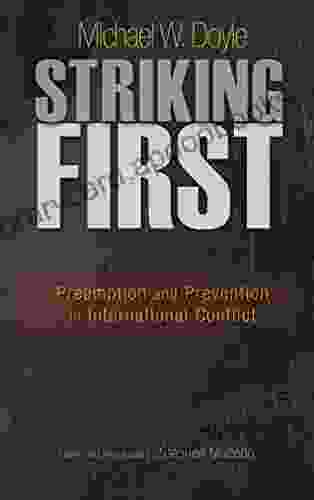Preempting Conflict: Unraveling the Strategies of Preemption and Prevention

In the realm of international relations, the specter of conflict looms ever present. Nations, driven by diverse interests and ambitions, often find themselves at odds, with the potential for violence and upheaval. To address this perpetual threat, policymakers and scholars have long grappled with the question of how to prevent or preempt such conflicts before they escalate into full-blown hostilities.
This article delves into the intricate world of preemption and prevention in international conflict, exploring the strategies, challenges, and ethical implications associated with these approaches. Drawing upon the insights of renowned scholars and real-world case studies, we will examine the complexities of preempting conflict and the delicate balance between security and restraint.
5 out of 5
| Language | : | English |
| File size | : | 1213 KB |
| Text-to-Speech | : | Enabled |
| Screen Reader | : | Supported |
| Enhanced typesetting | : | Enabled |
| Word Wise | : | Enabled |
| Print length | : | 201 pages |
Preemption: Striking First
Preemption refers to the use of military force against an adversary before they have launched an imminent attack. This proactive approach aims to neutralize threats before they materialize, potentially preventing a larger-scale conflict.
Proponents of preemption argue that it can be a necessary measure to safeguard national security. They point to cases like the 2003 invasion of Iraq, where the United States preemptively attacked Iraq's alleged weapons of mass destruction (WMD) program, claiming that it posed an imminent threat to the region.
However, preemption is a highly controversial strategy. Critics argue that it can lead to unnecessary wars and undermine international law. They also question the difficulty of accurately assessing the imminence of a threat and the potential for false positives.
Prevention: Addressing Root Causes
In contrast to preemption, prevention focuses on addressing the underlying causes of conflict before they escalate into violence. This approach seeks to create a more stable and peaceful international environment by resolving grievances, promoting cooperation, and fostering economic development.
Preventive measures can range from diplomatic negotiations and mediation to peacekeeping operations and arms control agreements. They aim to address issues such as bFree Download disputes, human rights violations, and economic inequality, which can all contribute to conflict.
Prevention is generally considered a more sustainable and ethical approach to conflict management. It seeks to address the root causes of violence rather than simply suppressing or responding to it. However, it can be a complex and time-consuming process that requires cooperation from all parties involved.
Balancing Security and Restraint
The choice between preemption and prevention is a complex one that policymakers must make in the face of often-uncertain information and competing priorities. Balancing national security with the need for restraint and international cooperation is essential.
In some cases, preemption may be justified if there is clear and imminent evidence of an impending attack. However, it should only be used as a last resort and with the greatest caution. Prevention should be the primary focus, addressing the underlying causes of conflict and building a more peaceful and stable international Free Download.
Case Studies: Lessons Learned
To better understand the complexities of preemption and prevention, let's examine some real-world case studies:
- Iraq War (2003): The United States preemptively invaded Iraq based on claims of WMDs. This controversial move has been widely criticized as an example of unjustified preemption.
- Oslo Accords (1993): This agreement between Israel and the Palestine Liberation Organization (PLO) aimed to prevent further conflict through negotiations and mutual recognition.
- Good Friday Agreement (1998): This agreement between the British government and Northern Irish political parties ended the decades-long conflict in Northern Ireland through a process of disarmament and power-sharing.
These case studies highlight the complexities of preemption and prevention. While preemption may sometimes be necessary, it must be used with caution and only when other options have been exhausted. Prevention is a more sustainable approach, but it requires patience, cooperation, and a commitment to long-term solutions.
Preemption and prevention are two essential strategies in the realm of international conflict management. While preemption can be a necessary measure in certain circumstances, prevention should be the primary focus. By addressing the root causes of conflict and building a more just and equitable international Free Download, we can reduce the likelihood of violence and create a more peaceful future for all.
5 out of 5
| Language | : | English |
| File size | : | 1213 KB |
| Text-to-Speech | : | Enabled |
| Screen Reader | : | Supported |
| Enhanced typesetting | : | Enabled |
| Word Wise | : | Enabled |
| Print length | : | 201 pages |
Do you want to contribute by writing guest posts on this blog?
Please contact us and send us a resume of previous articles that you have written.
 Book
Book Novel
Novel Page
Page Chapter
Chapter Text
Text Story
Story Genre
Genre Reader
Reader Library
Library Paperback
Paperback E-book
E-book Magazine
Magazine Newspaper
Newspaper Paragraph
Paragraph Sentence
Sentence Bookmark
Bookmark Shelf
Shelf Glossary
Glossary Bibliography
Bibliography Foreword
Foreword Preface
Preface Synopsis
Synopsis Annotation
Annotation Footnote
Footnote Manuscript
Manuscript Scroll
Scroll Codex
Codex Tome
Tome Bestseller
Bestseller Classics
Classics Library card
Library card Narrative
Narrative Biography
Biography Autobiography
Autobiography Memoir
Memoir Reference
Reference Encyclopedia
Encyclopedia Amber Richards
Amber Richards Ron L Deal
Ron L Deal Amir Khan
Amir Khan Darryl W Perry
Darryl W Perry Andie Michael
Andie Michael Lee Baker
Lee Baker Virginia Heath
Virginia Heath Kevin J Anderson
Kevin J Anderson Amelia Martens
Amelia Martens Annabel Soutar
Annabel Soutar Zach Wahls
Zach Wahls Bob Ossler
Bob Ossler Steven W Thrasher
Steven W Thrasher Theodore M Lechterman
Theodore M Lechterman Tim Rangnow
Tim Rangnow Amanda Skou
Amanda Skou Anders Engberg Pedersen
Anders Engberg Pedersen Amy Newmark
Amy Newmark Niomie Roland
Niomie Roland Anderson Bean
Anderson Bean
Light bulbAdvertise smarter! Our strategic ad space ensures maximum exposure. Reserve your spot today!
 Harry HayesFollow ·13.9k
Harry HayesFollow ·13.9k Darnell MitchellFollow ·2.8k
Darnell MitchellFollow ·2.8k Albert CamusFollow ·5.6k
Albert CamusFollow ·5.6k Gene SimmonsFollow ·17.3k
Gene SimmonsFollow ·17.3k Ryūnosuke AkutagawaFollow ·12.9k
Ryūnosuke AkutagawaFollow ·12.9k Ervin BellFollow ·12.6k
Ervin BellFollow ·12.6k Branden SimmonsFollow ·10.8k
Branden SimmonsFollow ·10.8k Eric NelsonFollow ·13.5k
Eric NelsonFollow ·13.5k

 Roald Dahl
Roald DahlImmerse Yourself in a Mesmerizing Tapestry of Creativity:...
Prepare to be captivated by "Spectra," an...

 Clarence Brooks
Clarence BrooksUnleash Your Inner Taylor with Red Piano Vocal Guitar:...
Embrace the Red Era...

 Jeffrey Hayes
Jeffrey HayesUnlock Your Child's Academic Potential: A Comprehensive...
In today's rapidly changing...

 William Golding
William GoldingBrave Elizabeth: A Captivating Tale of Resilience and...
Immerse Yourself in a Riveting Historical...

 Curtis Stewart
Curtis StewartUnveiling the Heartfelt Melodies of Taylor Swift: A...
Step into the enchanting world of Taylor...
5 out of 5
| Language | : | English |
| File size | : | 1213 KB |
| Text-to-Speech | : | Enabled |
| Screen Reader | : | Supported |
| Enhanced typesetting | : | Enabled |
| Word Wise | : | Enabled |
| Print length | : | 201 pages |













